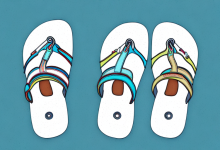The type of sandal you should wear often comes down to personal preference. However, it’s important to understand the benefits and drawbacks of each type of sandal in order to make the best decision. We have compared padded straps sandals to non-padded straps sandals to see which can provide the ideal balance of comfort and style.
Benefits of Padded Straps Sandals
Padded straps sandals provide extra cushioning over the top of your feet, making them ideal for those who require more support and comfort. The added cushioning and improved arch support helps reduce fatigue, leaving your feet feeling more energised. These sandals, as compared to their non-padded counterparts, also often last longer, as the padding helps protect the straps from rubbing and breaking down.
Padded straps sandals are also great for those who are on their feet for long periods of time, as the extra cushioning helps to reduce the impact of walking and running on hard surfaces. Additionally, the straps are often adjustable, allowing you to customize the fit of the sandal to your foot for maximum comfort.
Advantages of Non-Padded Straps Sandals
Non-padded straps sandals often come in a variety of stylish designs and materials, so they can be a great option if you’re looking for fashionable footwear. The thinner straps also make them lighter and allow your feet to breathe more freely. In addition, they are often more affordable than padded straps sandals due to the fewer materials and construction costs.
Non-padded straps sandals are also great for those who have sensitive feet, as the lack of padding can help reduce irritation and discomfort. Furthermore, they are often easier to clean and maintain than padded straps sandals, as the straps can be wiped down with a damp cloth. This makes them a great choice for those who are looking for a low-maintenance sandal.
Disadvantages of Padded Straps Sandals
Padded straps sandals are generally more expensive than their non-padded versions due to their more complex construction. They’re also typically heavier, due to the extra material and cushioning. As the padding can make them stiffer, some wearers might find themselves lacking the flexibility needed for certain activities such as walking up hills or running.
Drawbacks of Non-Padded Straps Sandals
Non-padded straps sandals are less supportive than padded straps sandals, so they might not provide the necessary arch support for all wearers. They are also more prone to rubbing and foot fatigue since there is no cushioning between your feet and the straps. Additionally, they can be less durable since they don’t have the same level of protection against wear and tear.
Impact on Comfort and Safety
The comfort level provided by each type of sandal depends on the individual wearer’s preference and needs. If comfort is your main concern, then padded straps sandals are usually a better option. However, non-padded straps sandals can also provide a reasonable degree of cushioning if properly broken in over time.
You should also consider safety when choosing between the two types of sandals. Padded straps sandals provide a better level of stability and grip due to their extra padding and material support. Non-padded straps sandals also offer enough traction when used on clean, dry surfaces, but if you plan on engaging in activities involving slippery surfaces then you will probably be better off with padded straps sandals.
Factors to Consider When Choosing Between the Two Types of Sandals
No single type of sandal is the perfect choice for all wearers. There are several other factors to take into account when choosing between padded straps sandals and non-padded straps sandals such as: intended activities, foot size and shape, arch support needs, personal preference and style, and cost.
Price Differences Between Padded and Non-Padded Straps Sandals
Padded straps sandals tend to be more expensive than non-padded straps sandals since they require additional materials and construction processes. However, this extra cost can be offset by their durability, cushioning, and added support.
Aesthetics and Style Considerations
The style and design of your sandal should also be taken into account when deciding which type to buy. Padded straps sandals typically come in a limited range of solid colors and designs, whereas non-padded versions come in much wider variety of styles such as patterned straps and colorful designs.
Durability Comparison
When it comes to durability, padded straps sandals often last longer due to the extra cushioning that helps protect the straps from wear and tear. Non-padded straps sandals can also be durable if properly taken care of, but their thinner straps can be prone to breakage if not properly maintained.
By taking into account all these factors, you can decide which type of sandal is the best choice for your particular needs and preferences. Both padded straps and non-padded straps sandals have their respective advantages and disadvantages, so make sure to carefully weigh all the factors before making your purchase.



